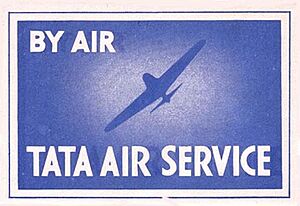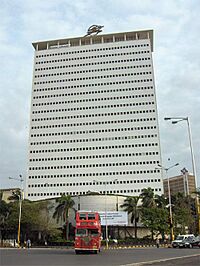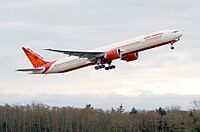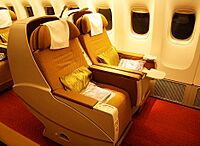Air India facts for kids
 |
|
| Founded | 15 October 1932 (as Tata Airlines) |
|---|---|
| Commenced operations | 29 July 1946 |
| Hubs | Delhi |
| Secondary hubs | Mumbai |
| Focus cities |
|
| Frequent-flyer program | Flying Returns |
| Alliance | Star Alliance |
| Subsidiaries | Air India Express |
| Fleet size | 140 |
| Destinations | 84 |
| Parent company | Air India Limited |
| Headquarters | Gurgaon, Haryana, India |
| Key people | |
| Revenue | |
| Profit | |
Air India is the flag carrier airline of India. It is owned by Air India Limited, a Tata Group enterprise and operates a fleet of Airbus and Boeing aircraft serving 102 domestic and international destinations. It is headquartered in Gurgaon. The airline has its main hub at Indira Gandhi International Airport, Delhi and secondary hub at Chhatrapati Shivaji Maharaj International Airport, Mumbai alongside several focus cities across India. As of July 2023[update], the airline is the second-largest airline in India in terms of passengers carried, after IndiGo. Air India became the 27th member of Star Alliance on 11 July 2014.
The airline was founded by J. R. D. Tata as Tata Airlines in 1932; Tata himself flew its first single-engine de Havilland Puss Moth, carrying air mail from Karachi to Bombay's Juhu aerodrome and later continuing to Madras (currently Chennai). After World War II, it became a public limited company and was renamed Air India. On 21 February 1960, it took delivery of its first Boeing 707 named Gauri Shankar and became the first Asian airline to induct a jet aircraft in its fleet. In 2000–01, attempts were made to privatise Air India and from 2006 onwards, it suffered losses after its merger with Indian Airlines. Another privatization attempt was launched in 2017, which concluded with ownership of the airline and associated properties reverting to the Tata Group in 2022.
Air India also operates flights to domestic and Asian destinations through its subsidiary Air India Express. Air India operates a mix of narrow body aircraft such as the Airbus A320 family and Boeing 737 used for most domestic and short-haul international routes and wide body aircraft such as the Airbus A350, Boeing 777 and Boeing 787 aircraft for long haul international routes. Air India's mascot is the Maharajah (Emperor) and the erstwhile logo consisted of a flying swan with the wheel of Konark inside it, before being replaced by a new logo inspired by the airline's Jharokha window pattern in 2023.
Contents
History
Early years (1932–1945)
Air India had its origin in Tata Sons, founded by J. R. D. Tata, an Indian aviator and business tycoon. In April 1932, Tata won a contract to carry mail for Imperial Airways and the aviation department of Tata Sons was formed with two single-engine de Havilland Puss Moths. On 15 October 1932, Tata flew a Puss Moth carrying air mail from Karachi to Bombay (currently Mumbai) and the aircraft continued to Madras (currently Chennai) piloted by Nevill Vintcent, a former Royal Air Force pilot and friend of Tata. The airline fleet consisted of a Puss Moth aircraft and a Leopard Moth. Initial service included weekly airmail service between Karachi and Madras via Ahmedabad and Bombay. In its first year of operation, the airline flew 160,000 miles (260,000 km), carrying 155 passengers and 9.72 tonnes (10.71 tons) of mail and made a profit of ₹60,000 (US$1,000). Later, the airline launched a domestic flight from Bombay to Trivandrum with a six-seater Miles Merlin. In 1938, it was re-christened as Tata Air Services and later as Tata Airlines. Delhi and Colombo were added to the destinations in 1938. During the Second World War, the airline helped the Royal Air Force with troop movements, shipping of supplies, rescue of refugees and maintenance of planes.
Post-Independence (1946–2000)
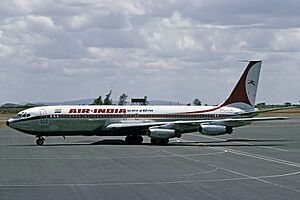
After World War II, regular commercial service was restored in India and Tata Airlines became a public limited company on 29 July 1946 under the name Air India. After the Indian independence in 1947, 49% of the airline was acquired by the Government of India in 1948. On 8 June 1948, a Lockheed Constellation L-749A named Malabar Princess (registered VT-CQP) took off from Bombay bound for London Heathrow marking the airline's first international flight. In 1953, the Government of India passed the Air Corporations Act and purchased a majority stake in the carrier from Tata Sons though its founder J. R. D. Tata would continue as chairman until 1977. The company was renamed as Air India International Limited and the domestic services were transferred to Indian Airlines as a part of restructuring. From 1948 to 1950, the airline introduced services to Nairobi in Africa and to major European destinations Rome, Paris and Düsseldorf. The airline took delivery of its first Lockheed Constellation L-1049 named Rani of Jhansi (registered VT-DGL) and inaugurated services to Bangkok, Hong Kong, Tokyo and Singapore.
On 21 February 1960, Air India International inducted its first Boeing 707–420 named Gauri Shankar (registered VT-DJJ), thereby becoming the first Asian airline to induct a jet aircraft in its fleet. The airline inaugurated services to New York on 14 May 1960. On 8 June 1962, the airline's name was officially truncated to Air India and on 11 June 1962, Air India became the world's first all-jet airline. In 1971, the airline took delivery of its first Boeing 747-200B named Emperor Ashoka (registered VT-EBD) and introduced a new Palace in the Sky livery and branding. In 1986, Air India took delivery of its first Airbus A310-300. In 1993, Air India took delivery of a Boeing 747-400 named Konark (registered VT-ESM) and operated the first non-stop flight between New York and Delhi.
Financial trouble, merger with Indian and later (2000–2022)
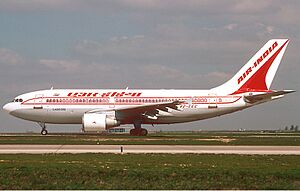
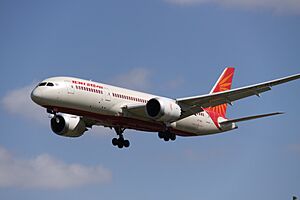
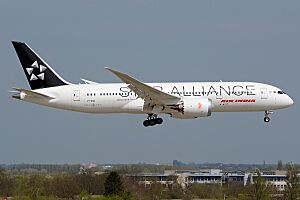
In 2000–01, attempts were made to re-privatize Air India. In 2000, Air India introduced services to Shanghai, China. On 23 May 2001, the Ministry of Civil Aviation charged Michael Mascarenhas, the then-managing director, with corruption. According to the ministry reports, the airline lost approximately ₹570 million (US$9.7 million) because of extra commissions that Mascarenhas sanctioned and he was later suspended from the airline. In May 2004, Air India launched a wholly owned low cost subsidiary called Air-India Express connecting cities in India with the Middle East and Southeast Asia. Until 2007, Air India mainly operated on international long-haul routes while Indian Airlines operated on domestic and international short-haul routes. In 2007, Air India and Indian Airlines were merged under Air India Limited and the airline took delivery of its first Boeing 777 aircraft. The airline was invited to be a part of the Star Alliance in 2007.
The combined losses for Air India and Indian Airlines in 2006–07 were ₹7.7 billion (US$130 million) and after the merger, it went up to ₹72 billion (US$1.2 billion) by March 2009. In July 2009, State Bank of India was appointed to prepare a road map for the recovery of the airline. The carrier sold three Airbus A300 and one Boeing 747-300M in March 2009 for $18.75 million to finance the debt. By March 2011, Air India had accumulated a debt of ₹426 billion (US$7.2 billion) and an operating loss of ₹220 billion (US$3.7 billion), and was seeking ₹429 billion (US$7.3 billion) from the government. A report by the Comptroller and Auditor General blamed the decision to buy 111 new planes and the ill-timed merger with Indian Airlines for the poor financial situation. In August 2011, the invitation to join Star Alliance was suspended as a result of its failure to meet the minimum standards for the membership. The government pumped ₹32 billion (US$540 million) into Air India in March 2012.
On 1 March 2009, Air India made Frankfurt Airport its international hub for onward connections to the United States from India. However, the airline shut down the Frankfurt hub on 30 October 2010 because of high operating costs. In 2010, financially less lucrative routes were terminated and the airline planned to open a new hub for its international flights at Dubai. In 2012, a study commissioned by the Corporate Affairs Ministry recommended that Air India should be partly privatised. In May 2012, the carrier invited offers from banks to raise $800 million via external commercial borrowing and bridge financing. In May 2012, the airline was fined $80,000 by the US Transportation Department for failing to post customer service and tarmac delay contingency plans on its website and adequately inform passengers about its optional fees.
In 2013, the then-Civil Aviation Minister Ajit Singh stated privatisation was the key to the airline's survival. However, the opposition led by the BJP and the CPI(M) slammed the government. In 2013, the Indian government planned to delay equity infusion of ₹300 billion (US$5.1 billion) that was slated to be infused into the airline slowly over eight years. In January 2013, Air India cleared a part of its pending dues through funds raised by selling and leasing back the newly acquired Boeing 787 Dreamliners. In March 2013, the airline posted its first positive EBITDA after almost six years and 20% growth in its operating revenue since the previous financial year. Air India Limited split its engineering and cargo businesses into two separate subsidiaries, Air India Engineering Services Limited (AIESL) and Air India Transport Services Limited (AITSL) in 2013. In December 2013, the airline appointed veteran pilot SPS Puri as its head of operations. The appointment was criticised by the Air India pilots union as Puri allegedly has multiple violations to his name.
Air India became the 27th member of Star Alliance on 11 July 2014. In August 2015, it signed an agreement with Citibank and State Bank of India to raise $300 million in external commercial borrowing to meet working capital requirements. For FY 2014–15, its revenue, operating loss and net loss were ₹198 billion (US$3.4 billion), ₹2.171 billion (US$37 million) and ₹5.41 billion (US$92 million) compared FY 2011–12, which were ₹147 billion (US$2.5 billion), ₹5.138 billion (US$87 million) and ₹7.55 billion (US$130 million). As of February 2016, Air India is the third largest carrier in India, after IndiGo and Jet Airways with a market share of 15.4%.
Post privatization (2022–present)
On 28 June 2017, the Government of India approved the privatisation of Air India and set up a committee to decide the details. In March 2018, the Government issued an Expression of Interest (EOI) to sell a 76% stake in Air India, along with low-cost airline Air India Express, and a 50% stake in AISATS, a ground handling joint venture with Singapore Airport Terminal Services (SATS). According to the EOI, the new owner would have to take on a debt of ₹33,392 crore (US$5.7 billion) and a bid would have to be submitted by mid-May as the Government wanted to complete the selling process by the end of 2018. However, no private firms showed any interest to buy a share in the debt-laden airline.
Having failed to sell off a majority stake in the airline, the Government decided to completely exit the airline and invited fresh EOIs on 27 January 2020. In order to attract bidders this time, the government reduced the debt burden on Air India by moving nearly ₹30,000 crore (US$5.1 billion) of the company's debts and liabilities to a Special Purpose Vehicle (SPV). In view of the prevailing situation arising out of COVID-19, the last date for submission of interest was extended multiple times and the Government eventually received EOIs from seven parties by December 2020. Five of these parties were disqualified and the Government invited financial bids for Air India from the two qualified parties in September 2021.
In September 2021, Spice Jet's Ajay Singh-led consortium and Tata Sons submitted their financial bids for Air India. On 8 October 2021, Air India along with its low cost carrier Air India Express and fifty per cent of AISATS, a ground handling company, were sold for ₹18,000 crore (US$3.1 billion) to Tata Group. On 27 January 2022, the airline was officially handed over to Tata Group. On 14 February 2022, after its re-privatization, the airline appointed İlker Aycı, former Chairman of Turkish Airlines as its new CEO and managing director to take charge on or before 1 April 2022 which did not materialize. In March 2022, Natarajan Chandrasekaran, the chairman of Tata Sons was appointed as the chairman of the airline and in May 2022, Campbell Wilson was announced as the CEO and MD.
After the airline's acquisition, Tata Group began discussion on bringing the other airlines including Vistara and AirAsia India where it held a stake under a unified umbrella. In November 2022, Air India acquired AirAsia's stake in AirAsia India, renamed it into AIX Connect and announced plans to merge it with Air India Express. On 29 November 2022, Air India announced the merger with Vistara by March 2024 with Singapore Airlines which owns a 49% stake in Vistara getting a 25% stake in the newly formed airline. Vistara brand would be discontinued post the merger and the brand will operate under the Air India name.
On 15 September 2022, the Tata Group announced Vihaan, a five-year transformation goal aimed at restructuring and transforming Air India in phases. As part of the plan, Air India announced flights to additional international destinations. The route expansion was supported by improving air-worthiness of existing fleet and leasing aircraft from other airlines. On 14 February 2023, Air India announced an order for 470 aircraft consisting of including 250 from Airbus and 220 from Boeing at a cost of US$70 billion, which set the record for the world's largest aircraft order at the time. On 10 August 2023, the airline announced a rebranding exercise named "Vista" with a new livery and logo. On 1 January 2024, Air India announced that it will begin operating its first Airbus A350 aircraft on domestic routes from 22 January 2024 before expanding to international destinations.
Corporate affairs and identity
Business trends
The key trends of Air India are (as at the financial year ending March 31):
| Financial Year (FY) | 2015-16 | 2016-17 | 2017-18 | 2018-19 | 2019-20 | 2020-21 | 2021-22 | 2022-23 |
|---|---|---|---|---|---|---|---|---|
| Revenue (₹Cr) | 20,610 | 22,177 | 23,003 | 26,487 | 28,524 | 12,104 | 19,815 | 31,377 |
| Net profit (₹Cr) | −3,836 | −6,281 | −5,337 | −8,556 | −7,982 | −7,083 | −9,591 | −11,388 |
| Number of passengers (mn) | 18.0 | 19.1 | 21.1 | 22.1 | 22.5 | 6.3 | 11.5 | 18.5 |
| Passenger load factor (%) | 75.6 | 76.3 | 80.0 | 79.0 | 79.8 | 68.4 | 73.5 | 81.9 |
| Freight carried (000 tonnes) | 192 | 196 | 204 | 240 | 221 | 74.9 | 169 | 175 |
| Fleet size | 135 | 136 | 158 | 171 | 127 | 124 | 165 | 127 |
| Reference |
Headquarters
Air India Limited is headquartered at the Indian Airlines House, New Delhi. Air India moved its headquarters from Air India Building, Mumbai to Delhi in 2013. The former headquarters is a 23-story tower on Marine Drive and was one of the targets of the 1993 Bombay bombings. In 2023, Air India moved its headquarters to Gurgaon in the National Capital Region.
Subsidiaries
Current
Air India Express began operations on 29 April 2005 and was initially owned by Air India Charters and operates flights from South India to the Middle East and Southeast Asia. In November 2022, Air India acquired AirAsia's stake in AirAsia India, renamed it into AIX Connect and announced plans to merge it with Air India Express.
Defunct
Air India became the first Asian airline to operate freighters when Air India Cargo was set up in 1954 and started its freighter operations with a Douglas DC-3 aircraft. Air India Cargo ended freighter aircraft operations in early 2012.
Alliance Air was a wholly owned subsidiary of Indian Airlines established on 1 April 1996. It started operations on 21 June 1996. It was renamed Air India Regional after the merger between Air India and Indian Airlines. It was renamed back to Alliance Air in 2017 and ceased being a subsidiary of Air India in April 2022 when the Government of India sold Air India to the Tata Group.
Mascot
Air India's mascot is the Maharajah (high king). It was created by Bobby Kooka, the then-commercial director of Air India, and Umesh Rao, an artist with J. Walter Thompson Limited in 1946. Kooka stated that, "We call him a Maharajah for want of a better description. But his blood isn't blue. He may look like royalty, but he isn't royal". Air India adopted the Maharajah as its mascot in 1946. It was used in promoting it although initially designed only for the airline's memo-pads. The Maharajah was given a makeover in 2015 and the brand is represented by a younger version. In 2023, the Maharajah was given a makeover and was revealed that the mascot would only be used in certain aspects of the airline like the premium lounges and crockery.
Logo and livery
Air India's colour scheme is red and white. The aircraft were painted white with red palace-style carvings on the outside of the windows and the airline's name written in red. The name is written in Hindi on the port side fuselage and in English on the port side tail. On the starboard side, the name is written in English on the fuselage, and in Hindi on the tail. The window scheme was designed in line with the slogan Your Palace in the Sky. The aircraft were earlier named after Indian kings and landmarks. In 1989, to supplement its Flying Palace livery, Air India introduced a new livery that included a metallic gold spinning wheel on a deep red-coloured tail and a Boeing 747, Rajendra Chola, was the first aircraft to be painted in the new colours.
The first logo of Air India was a centaur, a stylised version of Sagittarius shooting an arrow in a circle representing the wheel of Konark. The logo chosen by founder J. R. D. Tata was introduced in 1948 and represented the airline until 2007. On 22 May 2007, Air India and Indian Airlines unveiled their new livery consisting of a Flying Swan with the wheel of Konark placed inside it. The flying swan was morphed from the centaur logo and the chakra was derived from Indian's erstwhile logo. On 15 May 2007, Air India refreshed its livery, making the Rajasthani arches along the windows slightly smaller, extending a stylised line from the tail of the aircraft to the nose and painting the underbelly red. The new logo features on the tail and the engine covers with red and orange lines running parallel to each other from the front door to the rear door.
After the airline's acquisition by the Tata Group, the airline revealed its brand new logo and livery on 10 August 2023. The new livery features a palette of deep red, aubergine, and gold with chakra pattern and the new logo is inspired by the airline's Jharokha window pattern. In December 2023, the airline unveiled new uniforms for its crew and rolled out its new identity with an Airbus A350-900, the first aircraft to be re-branded.
Art collection
Air India maintained a collection of Indian art from 1956 comprising works of important Indian artists and photographers, sculptures, wood carvings, glass paintings, rare textiles etc. The artworks were often sent to be hung in Air India booking offices around the world and used in promotional material. In 1967, the company commissioned ashtrays from Salvador Dalí and gifted an elephant calf as payment. In 2010, a plan to establish a museum from the collection was stalled and the artworks reside in a building in Nariman Point, Mumbai. Air India organized the first ever exhibition of these art at the National Gallery of Modern Art in Delhi, titled Air India Salutes Indian Masters in 2013. Following a memorandum of understanding agreed between the airline and the Ministry of Culture, the art collection was transferred to the National Gallery of Modern Art (NGMA) in Mumbai in January 2023. The art was put up for exhibition titled Maharaja’s Treasure: Select Works of Art from the Famed Air India Collection.
Destinations
As of April 2024[update], Air India flies to a total of 84 destinations, including 44 domestic destinations and 40 international destinations in 37 countries across five continents around the world. Its primary hub is located at Indira Gandhi International Airport, New Delhi, and it has a secondary hub at Chhatrapati Shivaji Maharaj International Airport, Mumbai. Air India operates some of the world's longest non-stop flights.
Alliance
Air India became the 27th member of Star Alliance on 11 July 2014.
Air India has codeshare agreements with the following airlines:
- Air India Express (Subsidiary)
- Air Mauritius
- All Nippon Airways (begins 23 May 2024)
- Asiana Airlines
- Avianca
- Croatia Airlines
- Egyptair
- Ethiopian Airlines
- EVA Air
- Hong Kong Airlines
- LOT Polish Airlines
- Lufthansa
- Singapore Airlines
- SriLankan Airlines
- Swiss International Air Lines
- TAP Air Portugal
- United Airlines
Interline agreements
- Alaska Airlines
- Bangkok Airways
Fleet
As of April 2024[update], Air India operates a fleet of 133 aircraft, both narrowbody and widebody aircraft with a fleet composed of Airbus A319, A320, A320neo, A321, A321neo, A350 as well as the Boeing 777 and Boeing 787.
Fleet information
In 1932, Air India started operations with De Havilland Puss Moth. On 21 February 1960, Air India International inducted its first Boeing 707–420 named Gauri Shankar (registered VT-DJJ), thereby becoming the first Asian airline to induct a jet aircraft in its fleet. In 1971, the airline took delivery of its first Boeing 747-200B named Emperor Ashoka (registered VT-EBD) In 1986, Air India took delivery of its first Airbus A310-300. On 4 August 1993, Air India took the delivery of its first Boeing 747-400 named Konark (registered VT-ESM). In 1989, Indian Airlines introduced the Airbus A320-200 aircraft, which Air India now uses to operate both domestic and international short haul flights. In 2005, Indian Airlines introduced the smaller A319, which is now used mainly on domestic and regional routes. After the merger in 2007, Air India inducted the A321, to operate mainly on international short-haul routes and leased the Airbus A330s to operate on medium-long haul international routes. The airline's first Boeing 777-200LR aircraft was delivered on 26 July 2007, which was named Andhra Pradesh. Air India received its first Boeing 777-300ER aircraft on 9 October 2007 and the aircraft was named as Bihar. Air India received its first Boeing 787 dreamliner aircraft on 6 September 2012 and commenced flights on 19 September 2012.
Air India One is the call sign of any Air India aircraft carrying the Prime Minister, President or the Vice-President. Though the call-sign of Air India is used, these flights are operated on customized Boeing 777-300ER aircraft owned by Indian Air Force and maintained by Air India on a special contract.
Fleet restructuring
As a part of the financial restructuring, Air India sold five of its eight Boeing 777-200LR aircraft to Etihad Airways in December 2013. According to the airline, plans for introducing ultra-long flights with service to Seattle, San Francisco and Los Angeles were cancelled due to factors like high fuel prices and weak demand. In April 2014, the airline decided to sell its remaining three Boeing 777-200LRs as well, citing higher operating costs. On 24 April 2014, Air India issued a tender for leasing 14 Airbus A320 aircraft for up to six years, to strengthen its domestic network. By April 2024, Air India has sold four of its last remaining Boeing 747-400 jumbo jets US company AerSale. Two will be converted into freighters and two will be scrapped.
New aircraft orders
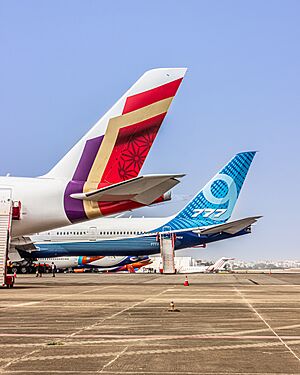
On 11 January 2006, Air India announced an order for 68 jets – 8 Boeing 777-200LR, 15 Boeing 777-300ER, 18 Boeing 737-800 and 27 Boeing 787-8 Dreamliners. The eighteen Boeing 737s ordered were later transferred to Air India Express and Air India took delivery of the dream liners.
On 14 February 2023, Air India announced an order for 470 aircraft with Airbus and Boeing consisting of 210 A320neo family, 40 A350, 190 737 MAX, 20 787-9 and 10 777-9 aircraft for US$70 billion with deliveries beginning late 2023.
Services
Cabin
The Boeing 777-200LRs/777-300ERs that have operated with Air India since before its privatization have a three-class configuration with first, business, and economy class. These include the carrier's older, 2-3-2 business class cabins and 3-3-3 economy class cabins. Following privatisation, Air India began operating ex-Delta 777-200LRs on certain routes to North America, which allowed for the airline to introduce Premium Economy (using Delta's Premium Select product). The introduction of ex-Etihad 777-300ERs on routes to London-Heathrow introduced a third product type within the carrier's fleet (though Premium Economy product is still limited to the ex-Delta 777s).
Air India's Boeing 787 Dreamliners have a similar product to its older 777s but do not have first class, opting for a two-class configuration with a 2-2-2 business class and economy class.
In January 2024, the airline introduced its first Airbus A350 on select domestic services.
Within its A320 fleet, which primarily serves domestic and regional international services, only business and economy class are offered, with some aircraft, including newly delivered A320/321neo aircraft having only economy class.
In-flight entertainment
Air India aircraft are equipped with Thales i3000 in-flight entertainment system. Passengers can choose from five channels airing Hindi and English content. Air India's Boeing 777 and 787 aircraft are also equipped with personal on-demand in-flight entertainment systems on which passengers can choose from available content. Showtime is the official entertainment guide published by Air India. Shubh Yatra (meaning Happy Journey) is a bilingual in-flight magazine published in English and Hindi by Air India.
Frequent flyer programme
Flying Returns is Air India's frequent-flyer programme. It was India's first frequent flyer programme and is shared by Air India and its subsidiaries. A member can earn mileage points and redeem them during future travel. On higher fares, passengers will earn bonus miles and clock mileage points.
Missions
As the flag carrier, Air India is often involved in the evacuation of civilians during wars. The airline entered the Guinness Book of World Records for the most people evacuated by civil airliner. Over 111,000 people were evacuated from Amman to Mumbai, a distance of 4,117 kilometres (2,558 mi), by operating 488 flights from 13 August to 11 October 1990 – lasting 59 days. The operation was carried out during Persian Gulf War to evacuate Indian expatriates from Kuwait and Iraq. The event was later featured in the film Airlift.
In February–March 2011, Air India evacuated more than 15,000 Indian nationals during the Libyan civil war. In March–April 2015, the airline was involved in Operation Raahat during the Yemeni civil war. In August 2021, Air India evacuated 669 people under Operation Devi Shakti from war-torn Afghanistan during the 2021 Taliban offensive. In February 2022, Air India evacuated Indian citizens from Russia and Ukraine as a part of Operation Ganga during the Russo-Ukrainian War. In October 2023, the airline evacuated people from Israel during the 2023 Israel–Hamas war as a part of Operation Ajay.
Awards and recognitions
- Preferred International Airline for travel and hospitality from Awaz Consumer Awards (2006)
- Best Corporate Social Responsibility Initiative by Galileo Express Travel World
- Best Short-Haul International Airline by Galileo Express Travel World (2008)
- Corporate Excellence Award by Amity University (2006)
- Trusted Brand by Reader's Digest (2006)
- Dun and Bradstreet Award (D&B), first in terms of revenue out of the top airline companies out of India (2006)
- Best South Asian Airline, Mice and business travel publications (2006)
- Cargo Airline of the Year, 26th Cargo Airline of the Year Awards
- Montreal Protocol Public Awareness Award by the United Nations for environmental protection
- Air India was named India's most trusted airline by The Brand Trust Report 2015.
Air India's ground services became the first ground service provider to acquire ISO 9002 certification on 31 January 2001.
Accidents and incidents
As of January 2024, Air India has been involved in ten fatal crashes, two of which were caused by acts of terrorism.
- On 27 December 1947, a Douglas C-48C (registered VT-AUG) carrying nineteen passengers and four crew en route from Karachi to Bombay, crashed at Korangi Creek due to loss of control following instrument failure, killing all on board. This was the airline's first fatal accident. The aircraft had been notorious for electrical problems and had an unusual number of instrument replacements.
- On 3 November 1950, Air India Flight 245, a Lockheed L-749 Constellation (registered VT-CQP, Malabar Princess) carrying forty passengers and eight crew on a flight from Bombay to London via Cairo and Geneva, crashed on Mont Blanc in France, killing all on board.
- On 13 December 1950, a Douglas C-47B (registered VT-CFK) carrying 17 passengers and four crew from Bombay to Coimbatore, crashed into high ground near Kotagiri due to a navigational error, killing all on board.
- On 15 September 1951, a Douglas C-47A (registered VT-CCA) lost control and crashed on takeoff from HAL Bangalore Airport with the autopilot turned on, killing a crew member; all 23 passengers survived.
- On 9 May 1953, a Douglas C-47A (registered VT-AUD) crashed shortly after takeoff from Palam Airport following a loss of control due to pilot error, killing all thirteen passengers and five crew on board.
- On 11 April 1955, Kashmir Princess, a Lockheed L-749A Constellation (registered VT-DEP) flying from Hong Kong to Jakarta, crashed while attempting a water landing post a mid-air bomb explosion in the right main landing gear bay, killing all eleven passengers and eight crew.
- On 19 July 1959 Rani of Aera, a Lockheed L-1049G Super Constellation (registered VT-DIN) carrying 46 people (39 passengers and seven crew) crashed on approach to Santacruz airport, Bombay in poor visibility conditions due to rain. There were no fatalities but the aircraft suffered damage beyond repair and was written off.
- On 24 January 1966, Air India Flight 101 Kanchenjunga, a Boeing 707-420 (registered VT-DMN) carrying 117 people (106 passengers and 11 crew) crashed on Mont Blanc, France killing all on board including Indian scientist Homi J. Bhabha.
- On 25 December 1974, Air India Flight 105, a Boeing 747-237B (registered VT-EBE), flying from Santacruz airport, Bombay to New York JFK, with stops at Beirut, Rome, and Paris was hijacked by a 31-year-old male passenger, while flying on the Beirut-Rome leg. The crew was able to subdue the hijacker, who was handed over to top Italian police officers after landing.
- On 1 January 1978, Air India Flight 855 Emperor Ashoka, a Boeing 747-200B (registered VT-EBD) crashed into the Arabian Sea post taking off from Bombay after the pilot became disorientated due to instrument failure, killing all 190 passengers and 23 crew on board.
- On 21 June 1982, Air India Flight 403 Gouri Shankar, a Boeing 707-420 (registered VT-DJJ) carrying 99 passengers and 12 crew from Kuala Lumpur to Bombay via Madras crashed while landing at Sahar airport during a rainstorm. The fuselage broke apart and seventeen people including two crew members were killed.
- On 28 January 1983, Air India Flight 306 Emperor Kanishka, a Boeing 747-200B (registered VT-EFO), collided with an Indian Airlines Airbus A300 after landing at Palam Airport, Delhi with the plane suffering substantial damage.
- On 2 June 1984, Air India flight 315, a Boeing 747-200B, flying from Bangkok to Delhi with 314 passengers and crew, suffered a No 4 engine fire five minutes after takeoff. While the fire extinguishers were armed, the fire persisted, forcing the plane to dump fuel and land at Bangkok Don Muang Airport. The fire was caused by a fuel leak on the left forward side of the engine near the air to fuel convertor valve. The plane was later repaired and put back to service.
- On 23 June 1985, Air India Flight 182, a Boeing 747-200B (registered VT-EFO), was blown up in mid-air by a suitcase-bomb planted by Babbar Khalsa terrorists on the first leg of its Montreal-London-Delhi-Bombay flight. The aircraft exploded off the coast of Cork, Ireland in the Atlantic Ocean killing all 307 passengers and 22 crew on board.
- On 7 May 1990, Air India Flight 132 Emperor Vikramaditya, a Boeing 747-200B (registered VT-EBO) flying on the London-Delhi-Bombay route carrying 215 people (195 passengers and 20 crew) caught fire on touch down at Delhi airport due to a failure of an engine pylon-to-wing attachment. There were no fatalities but the aircraft was damaged beyond repair and written off.
- On 30 July 2005, Air India Flight 127, a Boeing 747-400, flying from HAL Airport, Bangalore skidded while landing at Mumbai damaging the nose wheel landing gear after hitting a few runway lights. While there were no injuries, the plane sustained damage and was taken off service for repairs.
- On September 4, 2009, During the pre-takeoff phase at Chhatrapati Shivaji Maharaj International Airport in Mumbai, Air India Flight 829, a Boeing 747-400 (registered as VT-ESM), experienced an engine fire. As a result, the aircraft was declared a total loss, and 21 of the 229 individuals on board were injured while evacuating.
- On 28 May 2012, Air India flight 112, a Boeing 777-200LR (registered VT-ALH), suffered damage to the nose radar dome and left engine cowling on landing at Chhatrapati Shivaji Maharaj International Airport in Mumbai following a flight from London Heathrow. The cause of the damage could not be determined, but the aircraft was withdrawn from service to be repaired. The Boeing 777 returned to service in January 2015 after repairs and test flight were completed.
- On 5 January 2014, Air India flight 890, an Airbus A320 (registered VT-ESH), flying from Imphal to Delhi via Guwahati was diverted to Jaipur Airport due to heavy fog in Delhi. The rear tire of the plane burst during landing, damaging the right wing. While there were no fatalities among 173 passengers and 6 crew, the 20 year old Airbus suffered severe damage and was written off.
- On 17 December 2015, an Air India technician was killed in a freak accident at Chhatrapati Shivaji Maharaj International Airport in Mumbai after being sucked into the engine of an Airbus A320 during pushback when the co-pilot mistook a signal and started the engine.
- On 11 September 2018, Air India flight 101, a Boeing 777-300ER (registered VT-ALQ), operating from New Delhi to New York JFK airport, suffered multiple instrument failures and was unable to perform an ILS approach into any airport. Because of bad weather, the flight had to hold, resulting in a critical low fuel situation as well. The flight was able to divert to Newark, where it landed safely.
See also
 In Spanish: Air India para niños
In Spanish: Air India para niños
- List of airlines of India
- List of airports in India
- Transport in India


